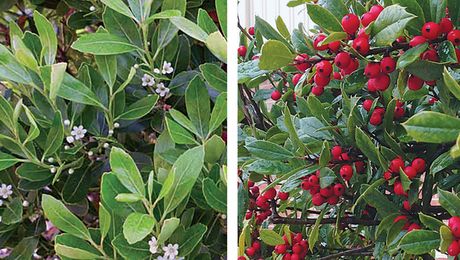
If you know the genus and species of this month’s mystery plant, you could win a free one-year subscription to Fine Gardening . Send your entry, along with your complete mailing address, by June 30, 2009 to [email protected] . The winner will be chosen at random from all correct entries.

Last month’s mystery plant was Actaea rubra, commonly known as red baneberry or snakeberry. This woodland perennial is native to North America and bears white flowers from the middle of spring to early summer, but it’s real claim to fame is its spikes of bright red berries. The plant grows to about 18 inches tall and 12 inches wide and prefers moist, rich soil in partial shade. It is hardy in USDA Hardiness Zones 4 to 8. Jane Horn of Prior Lake, Minnesota, was chosen at random from all correct entries to receive a free one-year subscription to Fine Gardening. Congratulations, Jane!
What eLetter subscribers have to say about Actaea rubra:
“I have one in my backyard and I love it.
-Lisa Dunn, Ellendale, Minnesota
“I think of this as the original Actaea, along with Actaea pachypoda (aka Doll’s Eyes), both of which are found in our local woodlands. Our beloved Cimicifuga has recently joined the ranks of the genus Actaea. It’s easy to see the resemblance, but I would prefer that the botanists didn’t reclassify plants that are well-established in the horticultural trade. The average gardener is already intimidated by scientific names, and changes like this just add to the mystery (and confusion)…
-Julie Finucane, Owosso, Michigan
“I grow it mainly for the berries, although the white blooms in the spring are nice too.”
-David Creech, Glen Ellyn, Illinois
“This plant is Actaea rubra or red baneberry. When I saw it in the New England Wildflower Society’s nursery, I had to buy several because they reminded me so much of my childhood in Maine. I got to my best friend and neighbor’s house by a path through the woods, which was bordered with baneberry, trillium, ferns and other wonderful woodland plants.”
-Kath Holland, North Easton, Massachusetts
“It is a common plant in the Fairbanks, Alaska, area. Children often confuse it with highbush cranberry during the berry picking season. The seeds of the baneberry are the best educational tool since one bad berry can spoil the whole batch of jelly.”
-Nancy Kuhn, Fairbanks, Alaska
“I’m hoping to be able to find several of these plants at our local native plant sale, which is coming up next weekend. It will make a nice groundcover among the white pines. It will also provide food for birds and some small mammals. Unfortunately, the berries are poisonous to people. This is a 3-season plant, providing interest in spring with its pretty, airy, white flowers. The glossy green leaves visually cool the heat of summer. Fall brings the wonderful red berries, which are shown in your newsletter. If you have a moist, shady, natural area or garden, red baneberry just might be the right plant for you! Thank you, Fine Gardening, for reminding your readers of this underused plant.”
-Julie Hughes, Potomac, Illinois
“This is a red baneberry (Actaea rubra). It’s in the buttercup family and grows as a native plant to New England. We have a couple of these in the natural area of our property. Beautiful plant!”
-Cindy Lussier, Southampton, Massachusetts
“I believe it is a red baneberry (Actaea rubra), which is one of my favorite woodland plants. Related to the white dolls’ eyes but I believe more beautiful.”
-Susan Clapp, Reedsburg, Wisconsin
“I have several on my property here in Maine.”
-Judy Hopkins, Pownal, Maine
Fine Gardening Recommended Products

A.M. Leonard Deluxe Soil Knife & Leather Sheath Combo
Fine Gardening receives a commission for items purchased through links on this site, including Amazon Associates and other affiliate advertising programs.

















Comments
Log in or create an account to post a comment.
Sign up Log in